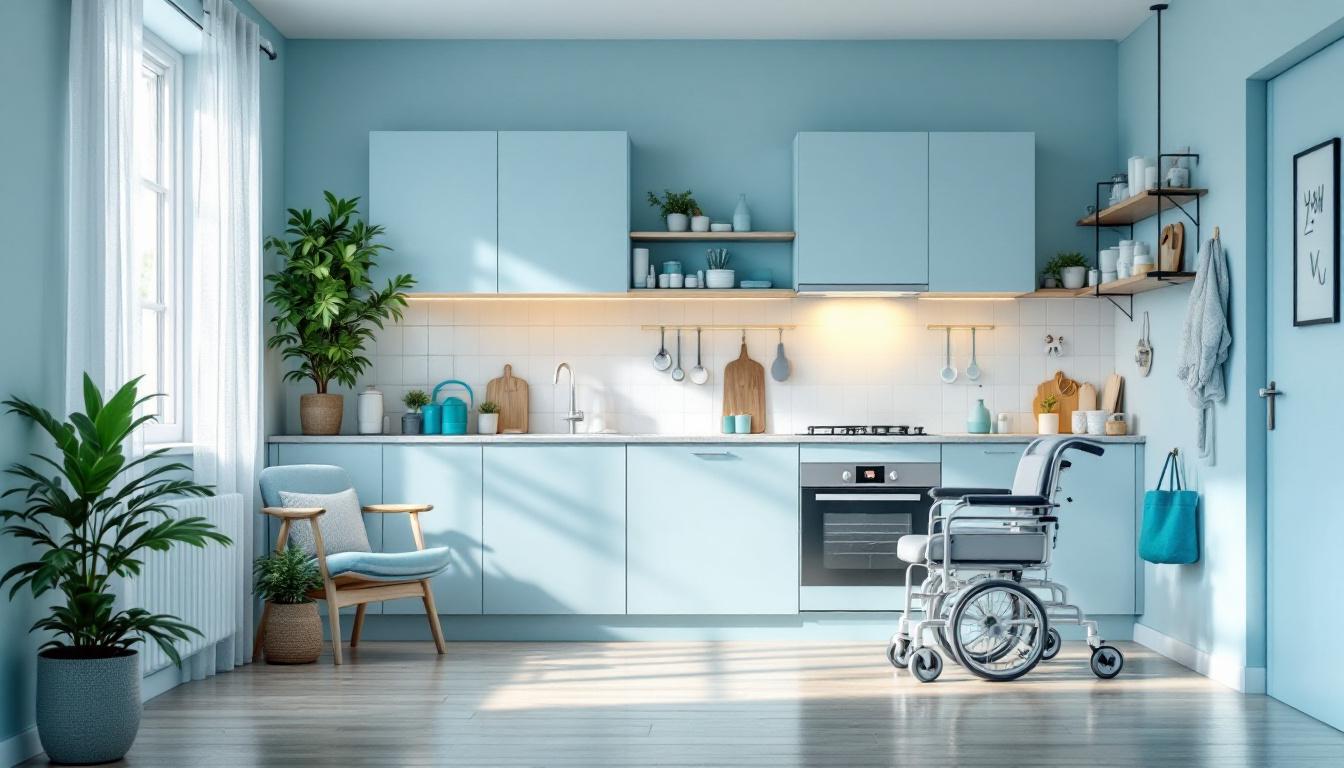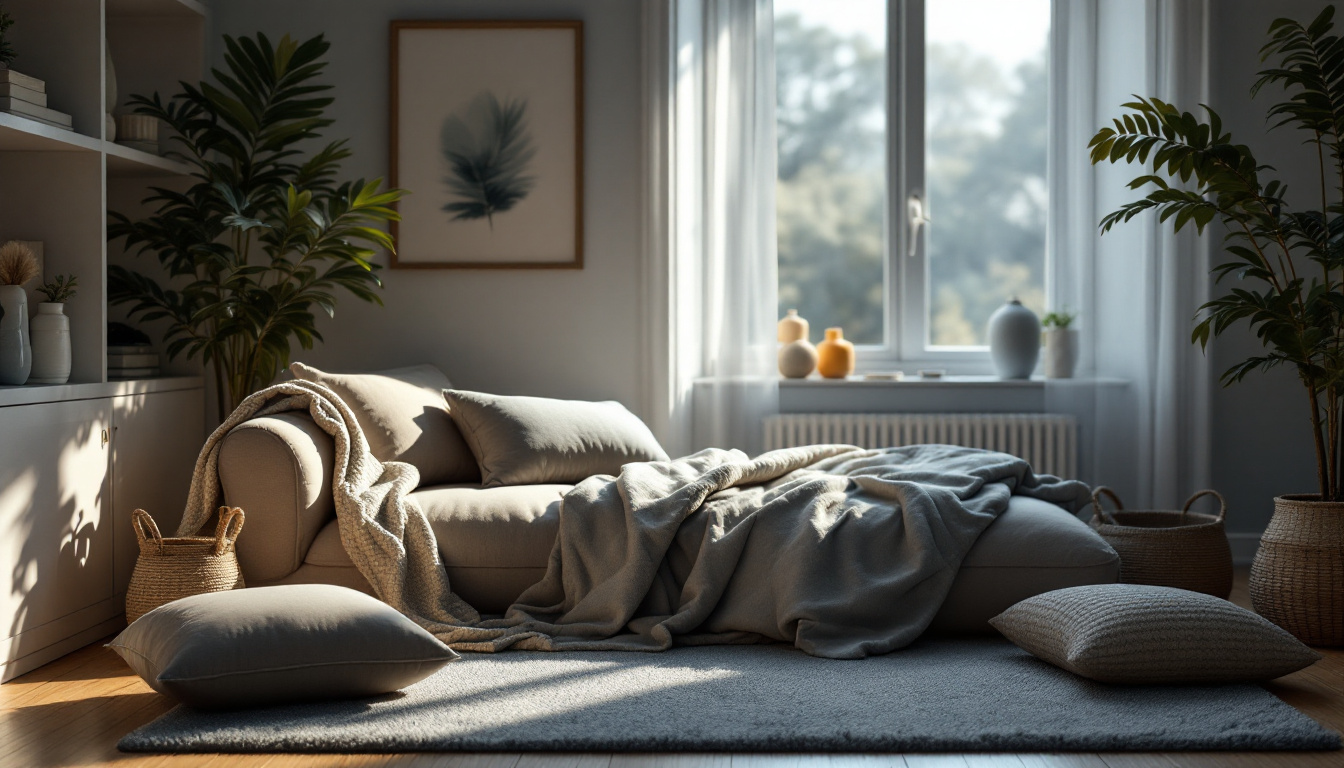Key Home Modifications for Disabilities
Discover key home modifications for disabilities that promote independence, safety, and accessibility. Transform your living space today!

Understanding Home Modifications
Home modifications play a crucial role in improving the lives of individuals with disabilities. These modifications aim to enhance accessibility, safety, and independence within the home environment. Understanding the impact of home modifications and the different types available is essential for creating an inclusive living space.

Impact of Home Modifications
Home modifications have been shown to have significant positive impacts on the lives of individuals with disabilities. Research conducted in Australia found that home modifications can reduce the hours of care provided by a caregiver. On average, home modifications resulted in a 42% reduction in hours of care per week, with a stronger reduction observed in informal care (46%) compared to formal care (16%).
Furthermore, home modifications have been found to enhance independence, autonomy, self-care, and overall well-being. They can reduce the need for informal care by approximately 6 hours per week on average, as well as decrease the need for formal care by around 0.36 hours per week on average. These modifications improve function, increase self-care abilities, and enhance the quality of life for individuals living at home with care needs.
Types of Home Modifications
There are various types of home modifications that can be implemented to address specific accessibility and safety needs. Some common types of home modifications include:
Bathroom Modifications
Bathroom modifications focus on improving accessibility and safety in this essential area of the home. They may include the installation of grab bars, adjustable showerheads, non-slip flooring, raised toilet seats, and roll-in showers or walk-in bathtubs. These modifications aim to enhance maneuverability and reduce the risk of falls.
Doorway and Hallway Widening
Widening doorways and hallways is crucial for individuals with mobility aids, such as wheelchairs or walkers. By increasing the width of doorways and hallways, individuals can navigate through their homes more easily. This modification may involve removing obstacles, adjusting door frames, and ensuring smooth transitions between rooms.
Threshold and Flooring Adjustments
Threshold and flooring adjustments focus on creating a seamless transition between different areas of the home. By eliminating or reducing thresholds, individuals with mobility challenges can move freely without encountering barriers. Additionally, choosing flooring materials that provide traction and reduce slipperiness can enhance safety.
By understanding the impact of home modifications and the different types available, individuals with disabilities can make informed decisions about the modifications they require. These modifications have the potential to improve independence, safety, and overall well-being, allowing individuals to thrive in their own homes.
Benefits of Home Modifications
Home modifications play a crucial role in improving the lives of individuals with disabilities by enhancing their independence, safety, and overall wellbeing. These modifications have been extensively studied and have shown positive outcomes for individuals living at home with care needs. Let's explore the key benefits of home modifications for disabilities.
Independence and Wellbeing
Research has shown that home modifications have a significant impact on the independence, autonomy, self-care, and wellbeing of individuals living at home with care needs, including older people and people with disabilities. By making necessary modifications to their living spaces, individuals can regain control over their daily activities and maintain a sense of independence.
Home modifications enable individuals to navigate their living spaces more easily, promoting self-reliance and reducing the need for assistance. This enhanced independence empowers individuals to engage in activities of daily living with greater ease and confidence. It can include modifications such as installing grab bars, ramps, or stairlifts, which facilitate mobility and accessibility throughout the home.
Safety and Accessibility
One of the primary goals of home modifications is to create a safe and accessible living environment for individuals with disabilities. These modifications can significantly contribute to the prevention of falls and injuries within the home. By removing barriers and hazards, individuals can move around their homes with reduced risk, enhancing their overall safety.
Home modifications aim to improve accessibility by adapting living spaces to meet the unique needs of individuals with disabilities. This can involve widening doorways and hallways, installing handrails, and modifying bathroom facilities to accommodate mobility aids and ensure ease of use. By making these changes, individuals can navigate their homes safely and comfortably, reducing the risk of accidents.
In addition to improving safety, home modifications also have a positive impact on physical health and overall wellbeing. Research has shown that these modifications can lead to increased quality of life, improved self-care abilities, and a reduction in the fear of falling [1]. By creating an accessible and safe living environment, individuals can experience improved physical health, reduced stress, and enhanced overall satisfaction with their living situation.
Home modifications for disabilities not only benefit the individuals directly but also have a broader positive impact. These modifications can improve multigenerational households, making everyday tasks easier for everyone. Furthermore, they can increase the appeal and value of a home when selling it.
By recognizing the benefits of home modifications, individuals with disabilities can take steps to create a living environment that promotes independence, safety, and overall wellbeing. Consulting professionals and utilizing available resources can help individuals identify the necessary modifications and ensure that their homes meet their unique needs.
Common Home Modifications
When it comes to making a home more accessible for individuals with disabilities, there are several common modifications that can greatly enhance safety and mobility. These modifications focus on areas of the home where accessibility and ease of use are especially critical. In this section, we will explore three of the most common home modifications: bathroom modifications, doorway and hallway widening, and threshold and flooring adjustments.
Bathroom Modifications
Bathroom modifications are essential for improving safety and accessibility, particularly for the elderly and individuals with disabilities. Bathrooms can be hazardous due to slick, wet surfaces, and traditional fixtures like bathtubs, showers, and toilets can be challenging and risky to use, increasing the risk of falls.
One key modification is the installation of grab bars. These bars provide stability and support, enhancing independence and reducing the risk of accidents, especially in areas prone to slips and falls. Grab bars can be designed for multigenerational use by incorporating the principles of universal design.
Other bathroom modifications may include the installation of accessible showers or walk-in tubs, the addition of non-slip flooring, and the adjustment of sink and toilet heights to accommodate individuals with varying mobility needs. These modifications aim to create a safe and accessible space, promoting independence and peace of mind.
Doorway and Hallway Widening
Widening doorways and hallways is another common home modification that improves accessibility and independence for individuals with disabilities. This modification is especially beneficial for those using mobility aids such as wheelchairs or walkers. By creating wider openings, individuals can navigate through the house with greater ease, eliminating the barriers posed by narrow doorways and hallways.
Doorway and hallway widening may involve removing door frames or adjusting wall placement to accommodate the desired width. This allows for smoother passage and ensures that individuals using mobility aids can move freely throughout the home. By eliminating physical obstacles, this modification enhances accessibility and promotes a sense of freedom and autonomy.
Threshold and Flooring Adjustments
Modifying thresholds and flooring is crucial for improving accessibility and reducing tripping hazards for individuals with disabilities or limited mobility. Uneven floor surfaces, particularly thresholds, can pose challenges and increase the risk of falls. Creating a smooth transition between rooms by installing ramps or threshold plates can enhance accessibility and safety within the home [3].
In addition to threshold adjustments, choosing flooring materials that offer slip resistance and ease of movement is essential. Non-slip flooring options, such as vinyl or textured tiles, can provide stability and reduce the likelihood of accidents. These modifications ensure that individuals can navigate their home with confidence and without the fear of tripping or stumbling.
By implementing bathroom modifications, doorway and hallway widening, and threshold and flooring adjustments, homes can become more accessible and inclusive for individuals with disabilities. These modifications promote safety, independence, and a greater sense of well-being, allowing individuals to thrive in their own living spaces.
Financial Assistance for Home Modifications
When it comes to making home modifications for disabilities, the cost can be a significant consideration. Fortunately, there are various financial assistance programs available to help individuals and families cover the expenses. This section will explore two main options: federal assistance programs and private grants and loans.
Federal Assistance Programs
The U.S. government offers several federal assistance programs to support individuals with disabilities in making necessary home modifications. These programs aim to improve accessibility and independence for those in need. Some notable programs include:
- U.S. Department of Veterans Affairs (VA) Grants: The VA offers grants to help service members and veterans modify their homes for qualifying service-related disabilities. The Specially Adapted Housing (SAH) grant provides up to $109,986 for fiscal year 2023, while the Special Home Adaptation grant offers up to $20,036 for FY 2023. Additionally, the Temporary Residence Adaptation grant provides up to $44,299 in FY 2023 for SAH-qualified individuals. These grants can significantly alleviate the financial burden of home modifications for eligible veterans [4].
- U.S. Department of Agriculture (USDA) Rural Housing Repair Loans and Grants: The USDA offers loans and grants to rural homeowners with very low income. The grants provide up to $7,500 for homeowners aged 62 and older, while loans up to $20,000 are available at a 1% interest rate over 20 years. Homeowners can combine grants and loans to finance their home modifications, making it an accessible option for those in rural areas.
- State and Local Agencies: State and local agencies often provide assistance for home modifications with less-restrictive qualification requirements. Programs like the U.S. Department of Housing and Urban Development (HUD) offer housing and homeownership resources for each state, including grants for home repairs. Additionally, the Independent Living Research Utilization program and the National Directory of Home Modification and Repair Resources can help individuals find support in their specific area.
Private Grants and Loans
In addition to federal assistance programs, there are private grants and loans available to fund home modifications for disabilities. Nonprofit organizations such as Rebuilding Together and Modest Needs offer financial support at the national or local level.
- Rebuilding Together: Rebuilding Together's volunteers work to make homes safer and more livable for low-income families, older adults, and people living with disabilities. They provide funding and assistance for home modifications, ensuring that individuals have access to safe and accessible living spaces.
- Modest Needs: Modest Needs provides Self-Sufficiency Grants for individuals living just above the poverty level. These grants can be used for a variety of needs, including accessible home modifications. Modest Needs aims to bridge the gap for those who may not qualify for government programs but still require financial assistance.
Private grants and loans can help individuals cover the costs of home modifications, making it more feasible to create an accessible and inclusive living environment.
It's important to note that the cost of home modifications for disabilities can vary depending on the scope of the project. Factors such as the type of modification and the extent of adjustments required will impact the overall expense. For instance, a full kitchen remodel can range from $13,000 to $38,000, while bathroom accessibility updates may cost between $3,000 and $15,000. Other common modifications, such as elevators, accessible showers, chairlifts, and grab bars, also have varying costs [4].
By exploring federal assistance programs, private grants, and loans, individuals with disabilities can find financial support to help make their homes more accessible and inclusive. These programs can provide the necessary resources to fund home modifications, promoting independence and improving the overall quality of life for individuals with disabilities.
Professional Assessments and Support
When it comes to making home modifications for individuals with disabilities, seeking professional assessments and support is crucial in ensuring that the modifications meet their specific needs. Professionals such as contractors, interior designers with expertise in home modifications, or occupational therapists can provide valuable insights and guidance throughout the process.
Evaluating Specific Needs
Before embarking on any home renovations, it is essential to evaluate the specific needs of individuals with disabilities. This evaluation helps identify the modifications required to enhance accessibility and improve their quality of life. Professionals can assess factors such as mobility challenges, sensory impairments, and specific requirements for daily activities. By understanding these needs, appropriate modifications can be planned and implemented, ensuring the modifications meet the individual's unique circumstances.
Professional Assistance Options
Several professionals can provide assistance throughout the home modification process. Here are some options to consider:
- Contractors: Contractors specializing in accessibility modifications can offer expertise in executing the necessary changes. They can help with structural modifications, such as widening doorways, installing ramps, and making structural adjustments to accommodate specific needs.
- Interior Designers: Interior designers with experience in home modifications for disabilities can provide guidance on optimizing space, selecting appropriate fixtures and fittings, and ensuring a balance between functionality and aesthetics. They can assist in creating an accessible and comfortable living environment.
- Occupational Therapists: Occupational therapists play a crucial role in assessing an individual's functional abilities and limitations. They can provide recommendations for modifications that promote independence and improve daily activities such as bathing, cooking, and mobility around the home. Occupational therapists can also guide individuals on assistive devices that may enhance their capabilities.
It is important to choose professionals with experience in home modifications for disabilities. Seek recommendations, review portfolios, and ensure that they understand the specific needs and challenges faced by individuals with disabilities.
By working with professionals who specialize in home modifications, individuals with disabilities can gain valuable insights and expertise to create an accessible and safe living environment. These professionals can help navigate the complexities of the modification process and ensure that the modifications meet the unique needs of each individual.
Specialized Home Modification Grants
When it comes to financing home modifications for disabilities, there are specialized grants available to assist individuals in making necessary changes to their homes. These grants are designed to provide financial support to help create a more accessible and inclusive living environment. In this section, we will explore three sources of specialized home modification grants: the U.S. Department of Veterans Affairs, the U.S. Department of Agriculture, and state and local agencies.
U.S. Department of Veterans Affairs
The U.S. Department of Veterans Affairs (VA) offers several grants to help service members and veterans modify their homes for qualifying service-related disabilities. These grants include:
- Specially Adapted Housing (SAH) Grant: This grant provides funding of up to $109,986 for fiscal year 2023 to help eligible individuals modify their homes to accommodate their specific needs.
- Special Home Adaptation (SHA) Grant: The SHA grant offers up to $20,036 for FY 2023 to assist veterans with service-connected disabilities in adapting their homes to enhance accessibility.
- Temporary Residence Adaptation (TRA) Grant: For individuals eligible for SAH benefits, the TRA grant offers up to $44,299 in FY 2023 to help them modify a family member's home to accommodate their temporary residence needs.
These grants aim to improve the safety and accessibility of homes for veterans with disabilities. For more information on eligibility and the application process, individuals can visit the U.S. Department of Veterans Affairs website.
U.S. Department of Agriculture
The U.S. Department of Agriculture (USDA) provides Rural Housing Repair loans and grants to rural homeowners with very low income. These programs offer financial assistance for home modifications to improve accessibility. The grants available through the USDA include:
- Rural Housing Repair Grants: Homeowners aged 62 and older may qualify for grants of up to $7,500. These grants can be used to make accessibility modifications to their homes.
- Rural Housing Repair Loans: Homeowners with very low income may be eligible for loans of up to $20,000. These loans are repaid monthly over 20 years at a low interest rate of 1%. Grants and loans can be combined to meet the specific needs of homeowners.
To learn more about the Rural Housing Repair loan and grant programs, interested individuals can visit the USDA's official website.
State and Local Agencies
State and local agencies also offer assistance for home modifications, often with less-restrictive qualification requirements. These agencies provide support to individuals seeking to make their homes more accessible. Some resources include:
- U.S. Department of Housing and Urban Development (HUD): HUD offers housing and homeownership resources for each state, including grants for home repairs. Individuals can explore their state-specific programs and funding options through HUD's official website.
- Independent Living Research Utilization program and the National Directory of Home Modification and Repair Resources: These resources provide information and support for individuals seeking home modification assistance. They can help connect individuals with relevant state and local agencies that offer grants and other resources.
Additionally, nonprofit organizations like Rebuilding Together and Modest Needs offer funding or assistance for accessible home modifications at the national or local level. Rebuilding Together's volunteers work to make homes safer and more livable for low-income families, older adults, and people living with disabilities. Modest Needs provides Self-Sufficiency Grants for individuals living just above the poverty level.
By exploring these specialized home modification grants, individuals with disabilities can find the necessary financial support to make their homes more accessible and inclusive. It's important to research and understand the specific requirements and application processes for each grant program to maximize the chances of securing the assistance needed.
References
- https://www.ncbi.nlm.nih.gov/pmc/articles/PMC6604004/
- https://www.bankrate.com/homeownership/home-improvements-for-people-with-disabilities/
- https://liveinplacedesigns.com/home-modification-elderly-and-disabled/
- https://www.nerdwallet.com/article/loans/personal-loans/accessible-home-modification-grants
































































































